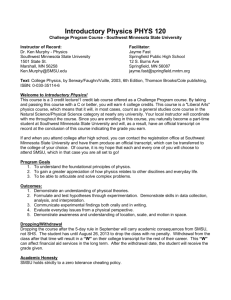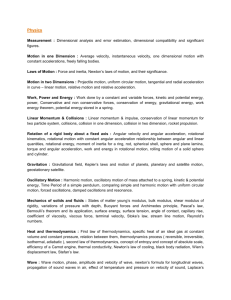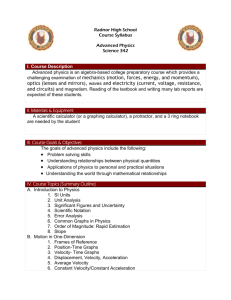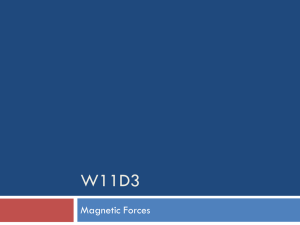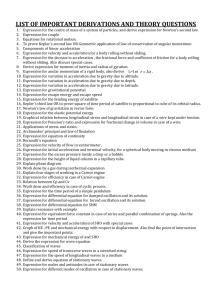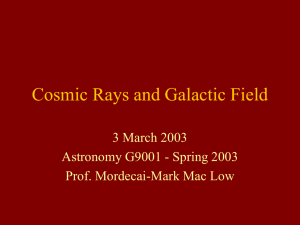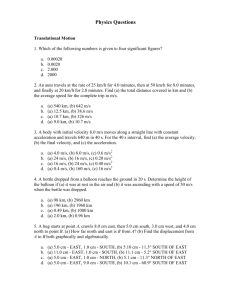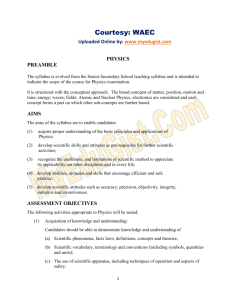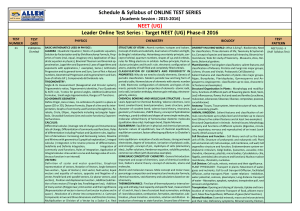THINGS TO KNOW FOR THE PHYSICS REGENTS
advertisement
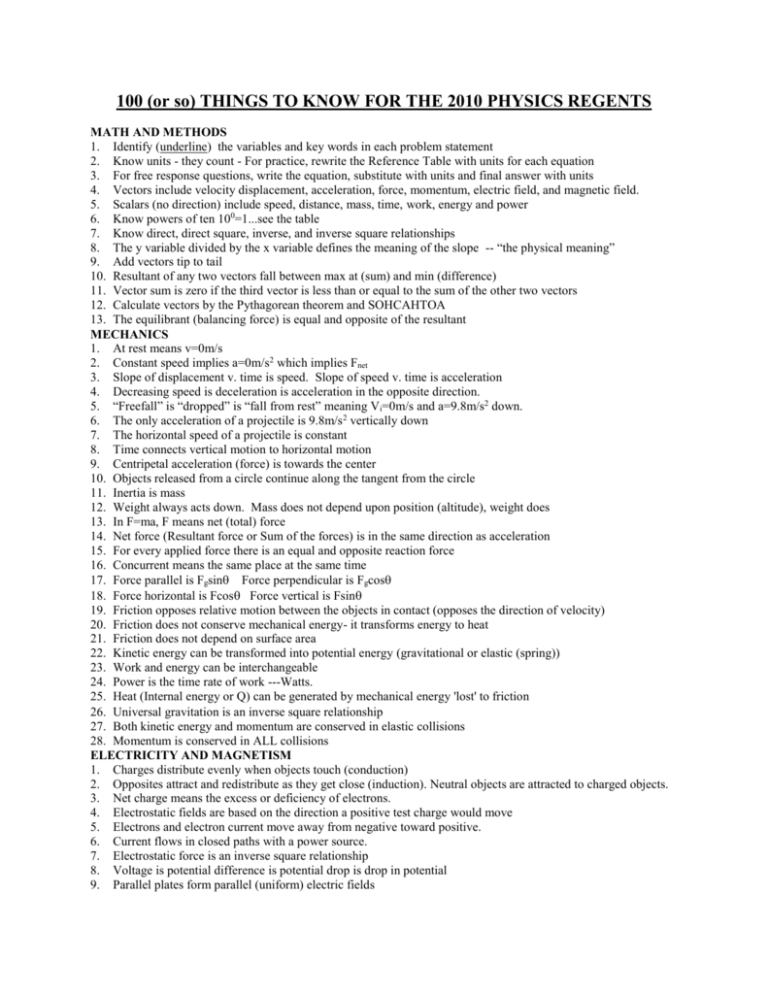
100 (or so) THINGS TO KNOW FOR THE 2010 PHYSICS REGENTS MATH AND METHODS 1. Identify (underline) the variables and key words in each problem statement 2. Know units - they count - For practice, rewrite the Reference Table with units for each equation 3. For free response questions, write the equation, substitute with units and final answer with units 4. Vectors include velocity displacement, acceleration, force, momentum, electric field, and magnetic field. 5. Scalars (no direction) include speed, distance, mass, time, work, energy and power 6. Know powers of ten 100=1...see the table 7. Know direct, direct square, inverse, and inverse square relationships 8. The y variable divided by the x variable defines the meaning of the slope -- “the physical meaning” 9. Add vectors tip to tail 10. Resultant of any two vectors fall between max at (sum) and min (difference) 11. Vector sum is zero if the third vector is less than or equal to the sum of the other two vectors 12. Calculate vectors by the Pythagorean theorem and SOHCAHTOA 13. The equilibrant (balancing force) is equal and opposite of the resultant MECHANICS 1. At rest means v=0m/s 2. Constant speed implies a=0m/s2 which implies Fnet 3. Slope of displacement v. time is speed. Slope of speed v. time is acceleration 4. Decreasing speed is deceleration is acceleration in the opposite direction. 5. “Freefall” is “dropped” is “fall from rest” meaning Vi=0m/s and a=9.8m/s2 down. 6. The only acceleration of a projectile is 9.8m/s 2 vertically down 7. The horizontal speed of a projectile is constant 8. Time connects vertical motion to horizontal motion 9. Centripetal acceleration (force) is towards the center 10. Objects released from a circle continue along the tangent from the circle 11. Inertia is mass 12. Weight always acts down. Mass does not depend upon position (altitude), weight does 13. In F=ma, F means net (total) force 14. Net force (Resultant force or Sum of the forces) is in the same direction as acceleration 15. For every applied force there is an equal and opposite reaction force 16. Concurrent means the same place at the same time Force parallel is FgsinForce perpendicular is Fgcos Force horizontal is FcosForce vertical is Fsin 19. Friction opposes relative motion between the objects in contact (opposes the direction of velocity) 20. Friction does not conserve mechanical energy- it transforms energy to heat 21. Friction does not depend on surface area 22. Kinetic energy can be transformed into potential energy (gravitational or elastic (spring)) 23. Work and energy can be interchangeable 24. Power is the time rate of work ---Watts. 25. Heat (Internal energy or Q) can be generated by mechanical energy 'lost' to friction Universal gravitation is an inverse square relationship 27. Both kinetic energy and momentum are conserved in elastic collisions 28. Momentum is conserved in ALL collisions ELECTRICITY AND MAGNETISM 1. Charges distribute evenly when objects touch (conduction) 2. Opposites attract and redistribute as they get close (induction). Neutral objects are attracted to charged objects. 3. Net charge means the excess or deficiency of electrons. 4. Electrostatic fields are based on the direction a positive test charge would move 5. Electrons and electron current move away from negative toward positive. 6. Current flows in closed paths with a power source. 7. Electrostatic force is an inverse square relationship 8. Voltage is potential difference is potential drop is drop in potential 9. Parallel plates form parallel (uniform) electric fields 10. Short, thick, cold wires have low resistance (Resistivity of metals is in the Table) 11. Series circuits have the same current throughout 12. Resistance in series circuits is the sum - always greater than largest resistor 13. Parallel circuits have the same voltage throughout 14. Resistance in parallel circuits is added as reciprocals - always less than the smallest resistor 15. Current into a junction equals current leaving a junction 16. Electric and magnetic fields are perpendicular 17. Forces on electrons and on current in a wire are perpendicular to the magnetic field 18. In a solenoid, more turns, more current and more iron in the core increase magnetism 19. Opposite magnetic poles attract. 20. There are no magnetic monopoles – only dipoles. 21. Magnetic fields are from north to south outside the magnet 22. A galvanometer can be made into an ammeter or a voltmeter 23. Ammeters connect in-line with (series with) a resistor 24. Voltmeters connect across (parallel with) a resistor 25. A changing electromagnetic field can produce a potential difference and a current in a wire 26. The fundamental charge and the subatomic masses are on the front of the reference table. 27. Transformers transmit power through changing magnetic fields/flux WAVES AND LIGHT 1. Model wave phenomena based on a rolling wave approaching you far out in the ocean 2. Waves transfer energy only, not matter 3. A full wavelength measures from crest to crest or trough to trough. 4. Mechanical waves need a medium, electromagnetic waves do not. (Radio waves are electromagnetic) 5. Transverse waves (such as light) vibrate perpendicular to the direction of propagation 6. Longitudinal waves (such as sound) vibrate in line with the direction of propagation 7. Constructive interference is from 2 waves in phase 8. Greater wavelength, greater distance, or smaller slit spacing increase diffraction effects. 9. Resonance causes objects to vibrate at their fundamental frequency (Opera glass, Musical instrument) 10. Color and pitch are frequency. Loudness and brightness are amplitude. 11. Doppler Effect causes red shift and sonic boom 12. High index of refraction means high optical density means slow speed 13. Measure angles with respect to the normal (perpendicular) line 14. FAST - fast to slow medium bend toward the normal/SOFA - slow to fast medium bend away from normal 15. Light bends and focuses in lenses due to refraction 16. Memorize the picture of refraction and dispersion through a prism. MODERN PHYSICS 1. Einstein’s photoelectric effect is evidence of the particle nature of light. 2. Compton demonstrated that the photon (quantized particle of light) has energy and momentum 3. Modern physics of Planck, Einstein, etc. shows that light has a particle nature 4. Modern physics of de Broglie shows that matter has a wave nature 5. Rutherford demonstrated that matter is mostly empty space 6. Bohr demonstrated electrons falling to lower energy levels release photons of light. (Jump up – absorb) 7. Nuclear forces are stronger than electrostatics or gravitation 8. Grand Unification Theory tries to combine all the forces and mass energy into one 9. Always conserve mass number – neutrons and protons (top) 10. Always conserve atomic number – protons (bottom) 11. Fission splits big things apart. Fusion smooshes small things together 12. Quarks come in threes to make an integer charge in baryons 13. The antimatter particles have a bar (or asterisk) above them ...they have opposite spin and charge 14. Quark with another antiquark is a meson. Quark with its own antiquark annihilates and releases energy. 15. Protons and neutrons are made of three quarks 16. The proton is up, up, down. The neutron is up, down, down 17. Leptons exist alone such as an electron or a neutrino 18. Mass defect (missing mass) times speed of light squared equals binding energy (E=mc2) 19. Use the E=mc2 equation with kg and J. Use the front of table for u and MeV.


